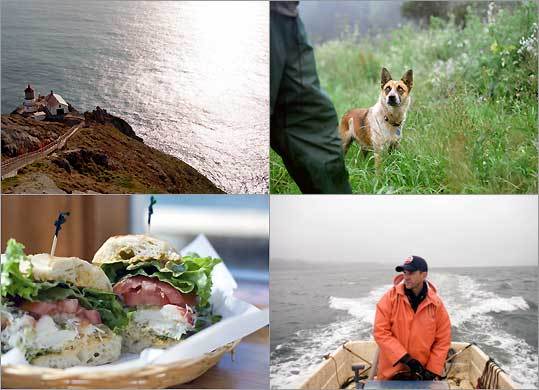Coastal meandering
Marin County’s wild sea and tall trees, cattle ranches and oyster beds

By Jonathan Levitt, Boston Globe, July 19, 2009
Link to article
SAUSALITO, Calif. - I’m driving through fog, heading north across the Golden Gate Bridge, toward the Shangri-La lushness that is Marin County. The Golden Gate - the strait below me where San Francisco Bay meets the Pacific Ocean - was called that long before there was a bridge. In the fog there is barely a bridge.
Traveling around the country, asking people about their favorite places, and about their most beautiful places, I heard again and again about the rolling ranchland and wild beaches of west Marin County. Here, the almost 70,000 acres of windswept wildness at Point Reyes National Seashore coexist with cattle ranches, dairy farms, and small organic market gardens. It makes for a balance that attracts tourists content to enjoy the seashore, hike in the hills, and eat good food. Chain stores and rowdy revelers are nowhere in sight.
East Coasters tend to idealize the charms of San Francisco. It’s like New York but the rosemary plants last all year, they’ll say, or, it’s like Boston, but with moody fog and mild winters and all those steep streets.
The city on the bay has all those things, but it’s also crowded and touristy. So it is a relief to cross the bridge and be immediately surrounded by the peace of Marin. On my way north to Seattle I took a short ramble through the area.
Sausalito, within sight of the bridge, was once a fishing village, a hideout for rum runners, an industrial shipyard, and a groovy summer-of-love houseboat community. The houseboats are still here, but these days a tiny one sells for almost half a million dollars and rents for a couple of thousand a month.
Fish, a year-old boutique clam shack right off the docks on the harbor, has a mission to serve only sustainable seafood. I order fish and chips: wild Alaskan halibut battered with locally brewed Anchor Steam beer. It’s $22, a lot for a fried lunch, but everything is perfect and it’s nice to sit in the sun and smell the bay.
Thus fortified, I head into the wilds of West Marin. My first stop is Muir Woods, 559 acres of protected land including a couple of hundred acres of old-growth coast redwood trees right off the highway and only minutes from Sausalito. In the cool fog it looks like heaven but smells like perfume from the busloads of tourists brought to gawk at the trees.
Bolinas feels like a secret - above the law and outside reality. Dogs run free on the sandy beach, hippies smoke weed and change diapers, surfers ride the gentle break, and clouds of shorebirds fill the sky. At Smiley’s Schooner Saloon an old guy falls asleep with his head on the bar. Susie Tompkins Buell, founder of Esprit, lives on a big spread here, and Alice Waters, the restaurateur, and Joel Coen, the movie director, supposedly live here. This is a beautiful, expensive place to live, and only one lovely hour from San Francisco.
Around the corner Tomales Bay Foods sells wine and local produce and Cowgirl Creamery cheeses, some of which you can watch being made in the spotlessly clean, glassed-in cheese room. I buy farm eggs, a wheel of triple crème cheese, the thickest asparagus, gnarly artisan bread, and a bottle of local Riesling.
I wander the quiet streets lined with Craftsman houses and then settle in for dinner at the bar at Stellina, a new restaurant near the bookstore which is packed and feels like a big city bistro and serves all manner of local and organic food. The bucatini with Tomales Bay Manila clams, parsley, garlic, and chives is a soulful taste of the place.
With no cheap motels for miles, I book a room at The Old Point Reyes Schoolhouse Compound, an old schoolhouse and barn set high on a sunny ridge just a short walk from town. Like my lunch at Fish, the barn loft at the compound is a worthwhile splurge. It has a full kitchen and a view of the hills and a garden - the perfect place to drink my wine and listen to the night.
In the morning I eat asparagus with the cheese and bread and boiled eggs, and then I make a run for Point Reyes National Seashore, an unusual mix of agriculture and wildness that is one of the most dramatically beautiful places on earth. Beef cattle graze right to the edge of old-growth forest and dairy farms slope down to dozens of miles of undeveloped beaches. I spend the morning hunting for bird and whale bones and sea glass on Kehoe Beach on the north end of the seashore. It’s quiet and isolated, accessible by a half-mile trail through marsh and pasture.
On my way out I stop at Drakes Bay Oysters, where farmer Kevin Lunny grows the luxurious bivalves on Drakes Estero right in the middle of the park. His is the only shucking and packing operation in the state. Right now he grows Pacific oysters but would like to switch to the native Olympia oysters, which he calls “the delicacy of all delicacies.’’ I’m happy with the Pacifics. I buy a dozen and sit by the shore shucking and slurping, wishing I had bought more wine.
North of Point Reyes Station the ranches roll on. On my way out of West Marin and up the coast I stop for a snack at The Marshall Store, a former general store right on Tomales Bay. The owners serve Dungeness crab sandwiches, creamy clam chowder, and deep-cupped oysters either raw or grilled over a hot fire. I order a crab sandwich and more oysters and sit outside watching the bay.
At dusk the water is dead calm. There is drizzle and the drone of tree frogs. The tall grass is alive with red-winged blackbirds. In this place, the down comforters, the cheese and wine stand out against the rain and the hills and the infinite ocean. It all makes for a place that is difficult to leave.
Jonathan Levitt can be reached at www.jonathanlevitt.com



